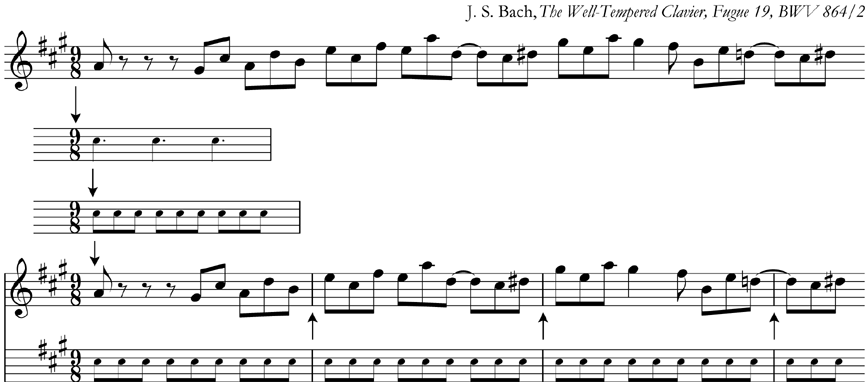Time signatures level 4
In this guide...
Key terms:
Subscription required!
To view the complete study guide, you will need a valid subscription. Why not subscribe now?
Already have a subscription? Make sure you login first!
Introduction
Building on the compound time signatures we met in Time signatures level 3, let's fill out the picture and look at some more examples of compound time signatures.
Compound time
Recall that in compound duple time, we count the same number of beats as in simple duple time, but that each beat consists of three subdivisions rather than two, as shown here:
 Counting in 2/4 and 6/8
Counting in 2/4 and 6/8More time signatures
The time signature in compound time shows the number of subdivisions, rather than the number of beats; so in the case of 6/8, the time signature tells us that there are 6 eighth notes, or quavers, to a bar. These are grouped into two beats, each of a dotted crotchet.
Just as we can go from 2/4 to 6/8, it is possible to go from 2/8 (two quaver beats, subdividing to two groups each of two semiquavers) to 6/16 (two dotted quaver beats, each subdividing into groups of three semiquavers).
Similarly, we can go from 3/2 to 9/4: three minim beats, (each subdividing into two crotchets), to three dotted minim beats, each subdividing into three crotchets.
Missing barlines
It is particularly important to know these groups in compound time signatures when you have to write in barlines. Here is an example question that asks you to write in the barlines for some music in 9/8.
As you can see, the first step is to identify the beats and groups of notes, which in 9/8 we know are three beats subdividing into three quavers each:
 Q. This music begins on the first beat of the bar. Add the missing barlines.
Q. This music begins on the first beat of the bar. Add the missing barlines.In summary
In summary, here are all the simple and compound time signatures you are likely to meet - simple and compound; duple, triple, and quadruple:
Duple time:
| Time signature | Beat length | Description | Beat groups |
|---|---|---|---|
 | minim | simple duple |  + +  ) ) |
 | dotted minim | compound duple |  + +  ) ) |
 | crotchet | simple duple |  + +  ) ) |
 | dotted crotchet | compound duple |  + +  ) ) |
 | quaver | simple duple |  + +  ) ) |
 | dotted quaver | compound duple |  + +  ) ) |
Triple time:
 | minim | simple triple |  + +  + +  ) ) |
 | dotted minim | compound triple |  + +  + +  ) ) |
 | crotchet | simple triple |  + +  + +  ) ) |
 | dotted crotchet | compound triple |  + +  + +  ) ) |
 | quaver | simple triple |  + +  + +  ) ) |
 | dotted quaver | compound triple |  + +  + +  ) ) |
Quadruple time:
 | minim | simple quadruple |  + +  ) ( ) ( + +  ) ) |
 | dotted minim | compound quadruple |  + +  ) ( ) ( + +  ) ) |
 | crotchet | simple quadruple |  + +  ) ( ) ( + +  ) ) |
 | dotted crotchet | compound quadruple |  + +  ) ( ) ( + +  ) ) |
 | quaver | simple quadruple |  + +  ) ( ) ( + +  ) ) |
 | dotted quaver | compound quadruple |  + +  ) ( ) ( + +  ) ) |
Read more...
With a subscription to Clements Theory you'll be able to read this and dozens of other study guides, along with thousands of practice questions and more! Why not subscribe now?
Revision
Are you sure you've understood everything in this study guide? Why not try the following practice questions, just to be sure!